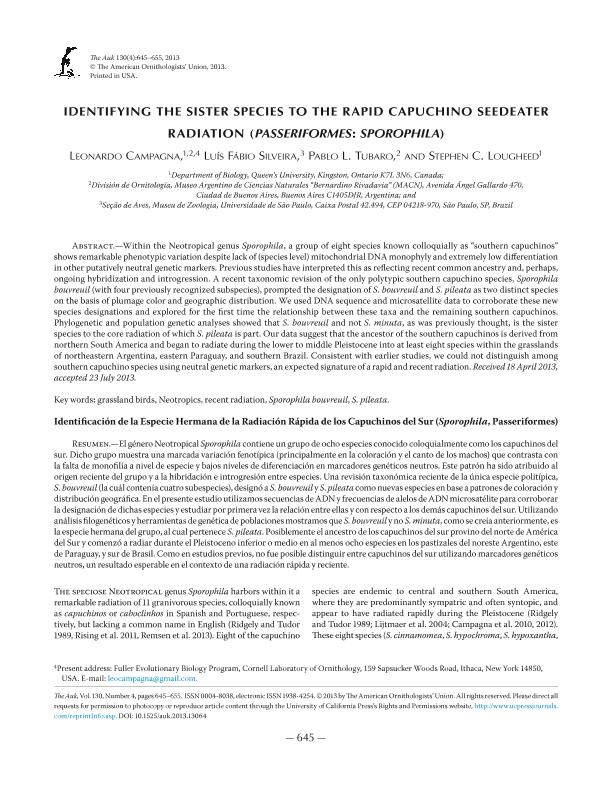Artículo
El género Neotropical Sporophila contiene un grupo de ocho especies conocido coloquialmente como los capuchinos del sur. Dicho grupo muestra una marcada variación fenotipica (principalmente en la coloración y el canto de los machos) que contrasta con la falta de monofilia a nivel de especie y bajos niveles de diferenciación en marcadores genéticos neutros. Este patrón ha sido atribuido al origen reciente del grupo y a la hibridacion e introgresion entre especies. Una revision taxonómica reciente de la única especie politípica, S. bouvreuil (la cuál contenía cuatro subespecies), designó a S. bouvreuil y S. pileata como nuevas especies en base a patrones de coloración y distribución geográfica. En el presente estudio utilizamos secuencias de ADN y frecuencias de alelos de ADN microsatélite para corroborar la designación de dichas especies y estudiar por primera vez la relación entre ellas y con respecto a los demas capuchinos del sur. Utilizando análisis filogenéticos y herramientas de genetica de poblaciones mostramos que S. bouvreuil y no S. minuta, como se creia anteriormente, es la especie hermana del grupo, al cuál pertenece S. pileata. Posiblemente el ancestro de los capuchinos del sur provino del norte de América del Sur y comenzó a radiar durante el Pleistoceno inferior o medio en al menos ocho especies en los pastizales del noreste Argentino, este de Paraguay, y sur de Brasil. Como en estudios previos, no fue posible distinguir entre capuchinos del sur utilizando marcadores genéticos neutros, un resultado esperable en el contexto de una radiación rápida y reciente. Within the Neotropical genus Sporophila, a group of eight species known colloquially as “southern capuchinos” shows remarkable phenotypic variation despite lack of (species level) mitochondrial DNA monophyly and extremely low differentiation in other putatively neutral genetic markers. Previous studies have interpreted this as reflecting recent common ancestry and, perhaps, ongoing hybridization and introgression. A recent taxonomic revision of the only polytypic southern capuchino species, Sporophila bouvreuil (with four previously recognized subspecies), prompted the designation of S. bouvreuil and S. pileata as two distinct species on the basis of plumage color and geographic distribution. We used DNA sequence and microsatellite data to corroborate these new species designations and explored for the first time the relationship between these taxa and the remaining southern capuchinos. Phylogenetic and population genetic analyses showed that S. bouvreuil and not S. minuta, as was previously thought, is the sister species to the core radiation of which S. pileata is part. Our data suggest that the ancestor of the southern capuchinos is derived from northern South America and began to radiate during the lower to middle Pleistocene into at least eight species within the grasslands of northeastern Argentina, eastern Paraguay, and southern Brazil. Consistent with earlier studies, we could not distinguish among southern capuchino species using neutral genetic markers, an expected signature of a rapid and recent radiation.
Identifying the Sister Species to the Rapid Capuchino Seedeater Radiation (Passeriformes: Sporophila)
Fecha de publicación:
10/2013
Editorial:
American Ornithologists' Union
Revista:
Auk
ISSN:
0004-8038
e-ISSN:
1938-4254
Idioma:
Inglés
Tipo de recurso:
Artículo publicado
Clasificación temática:
Resumen
Palabras clave:
Grassland Birds
,
Neotropics
,
Recent Radiation
,
Sporophila Bouvreuil
,
S. Pileata
Archivos asociados
Licencia
Identificadores
Colecciones
Articulos(MACNBR)
Articulos de MUSEO ARG.DE CS.NAT "BERNARDINO RIVADAVIA"
Articulos de MUSEO ARG.DE CS.NAT "BERNARDINO RIVADAVIA"
Citación
Campagna, Leonardo; Silveira, Luis Fabio; Tubaro, Pablo Luis; Lougheed, Stephen C.; Identifying the Sister Species to the Rapid Capuchino Seedeater Radiation (Passeriformes: Sporophila); American Ornithologists' Union; Auk; 130; 4; 10-2013; 645-655
Compartir
Altmétricas




